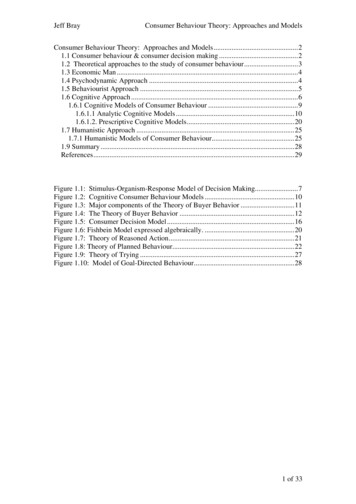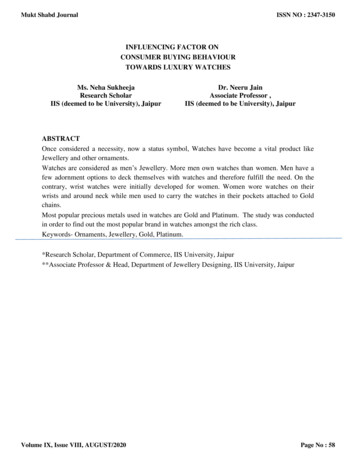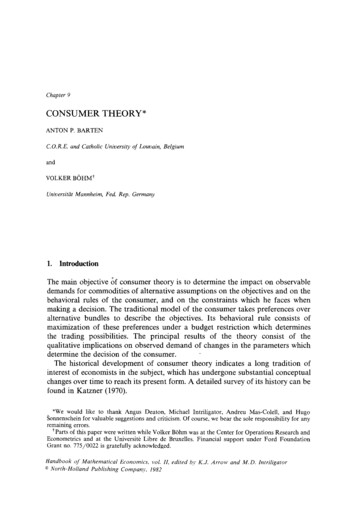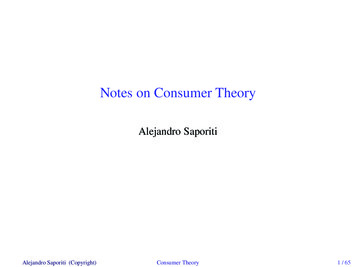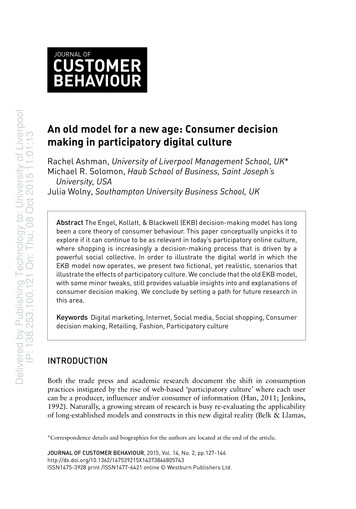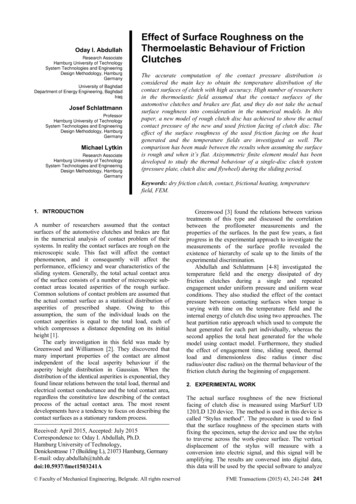
Transcription
THEORY OF CONSUMERBEHAVIOURPreferencesUtilityIndifference curves
THEORY OF CONSUMER BEHAVIOURPreferences; Utility; Indifference curvesSTRUCTURE OF PRESENTATION 1. Preferences 2. Total and marginal utility 3. Cardinal and ordinal utility 4. Indifference curves
1. Preferences(1/2) UTILITY THE ABILITY OF A GOOD TO SATISFY HUMAN WANTS the utility or how the consumer values different commodities is connectedwith his PREFERENCES.Axioms of preferences:1. Completeness:Consumer can rank (compare) all available consumption bundles. So forany two bundles of goods A and B he can establish a preference orderingand choose one of the following possibilities:a) A is preferred to B (A B, or A B),b) B is preferred to A (B A, or B A),c) A and B are equally good, consumer is indifferent between A and B(A B).
1. Preferences(2/2)2. Transitivity:For any three consumption bundles A, B and C it is valid that if consumerprefers A to B, and he prefers B to C, then he must prefer A to C.Consumer is consistent in his preferences.3. Non-Satiation or Greed:Consumer always places positive value on more consumption; he prefersmore of a commodity to less.4. Reflexivity:For any two bundles of goods A and B which are identical the consumerwill consider A to be at least as good as B (A is weakly preferred to B).Alternatively we can say, the consumer is indifferent between A and B.
1. Total and marginal utility(1/3) TOTAL UTILITY (TU) the total satisfaction received from consuminggoods or services and it depends on quantities of goods consumed.Total utility of N goods is a function of quantities consumed:TU f(Q1,Q2, ,Qi, ,QN), i 1,2,.,NTU – total utility,Qi – quantity consumed of good i,i – good.
1. Total and marginal utility(2/3) MARGINAL UTILITY (MU) extra utility received from consuming oneadditional unit of good i while holding constant the quantityconsumed of all other goods.MUi TU, Qii 1,2, ,NMUi the marginal utility of good i,TU – total utility,Qi – quantity consumed of good i,i – good.
1. Total and marginal utility(3/3) Law of diminishing marginal utility – each additional unitof a good eventually gives less and less extra utility thanthe previous additional unit.
2. Cardinal and ordinal utility(1/1)CARDINAL UTILITY means that an individual can measure his utility and canattach specific values of utility from consuming each quantityof a good or basket of goods. provides an actual measure of satisfaction in units.ORDINAL UTILITY ranks utility received from consuming different amounts ofgoods or baskets of goods; ranks various consumption bundles(! no units !). in fact it is the preference function of the consumer (andapplies properties of preferences completeness, transitivity,non-satiation, reflexivity).
3. Indifference curves(1/10) INDIFFERENCE CURVE the curve showing the various combinations of twocommodities that give the consumer equal level of total utility.Higher indifference curve higher level of satisfactionLower indifference curve lower level of satisfaction
3. Indifference curves(2/10)CHARACTERISTICS OF INDIFFERENCE CURVES:1. There are infinitely many indifference curves2. Indifference curves cannot intersect it violates transitivity of preferences.
3. Indifference curvesCHARACTERISTICS OF INDIFFERENCE CURVES:3. Indifference curves are negatively sloped.(3/10)
3. Indifference curvesCHARACTERISTICS OF INDIFFERENCE CURVES:4. Indifference curves are convex to the origin.(4/10)
3. Indifference curves(5/10)SLOPE OF INDIFFERENCE CURVES: is negative refers to the amount of one good that an individual is willing to give up for anadditional unit of another good while maintaining the same level of totalutility. MARGINAL RATE OF CONSUMER SUBSTITUTION (MRCS) absolute slope of theindifference curve may be different at every point along the curve. to find the slope of a curve in certain point we must find the slope of a linetangent to the curve at the selected point. Q𝟐ΔQ2(or) Q𝟏ΔQ1
3. Indifference curves(6/10) all combinations of good 1 and good 2 on a given indifference curve bringthe same level of total utility for the consumer (change of total utility is zero) TU(Q1,Q2) 0 TU(Q1,Q2) TU(Q1,Q2) Q1 Q2 0 Q1 Q2MUQ1 Q1 MUQ2 Q2 0 Q2MUQ1 MUQ2 Q1 MRCS is equal to the ratio of marginal utilities: Q2MUQ1 MUQ2 Q1MUQ1MRCS MUQ2MRCS
3. Indifference curvesSPECIAL TYPES OF INDIFFERENCE CURVES(7/10)
3. Indifference curves(8/10)SPECIAL TYPES OF INDIFFERENCE CURVES ACORDING TO PREFERENCE ORDERINGGood / normal / superior good more of a commodity is preferred to lessBad / inferior good less of a commodity is preferred to moreNeuter indifference between having more or less of a commodity
3. Indifference curves(9/10)SPECIAL TYPES OF INDIFFERENCE CURVES ACORDING TO PREFERENCE ORDERING
3. Indifference curves(10/10)SPECIAL TYPES OF INDIFFERENCE CURVES ACORDING TO PREFERENCE ORDERING
arginal-utility.htmhttps://www.youtube.com/watch?v Yfslg-hFSiMhttps://www.youtube.com/watch?v TS2094-On ordinal utility Gavino/indifference-curves-6187452Next lesson THEORY OF CONSUMER BEHAVIOUR1. Consumer s utility2. Budget constraint3. Choice of rational consumer
THANK YOU FOR YOUR ATTENTION!
Consumer is consistent in his preferences. 3. Non-Satiation or Greed: Consumer always places positive value on more consumption; he prefers more of a commodity to less. 4. Reflexivity: For any two bundles of goods A and B which are identical the consumer will consider A to be at least as good as B (A is weakly preferred to B).File Size: 1MBPage Count: 20

